
The National Register of Historic Places in the United States is a register including buildings, sites, structures, districts, and objects. The Register automatically includes all National Historic Landmarks as well as all historic areas administered by the U.S. National Park Service. Since its introduction in 1966, more than 90,000 separate listings have been added to the register.

This is a list of properties and historic districts in Missouri on the National Register of Historic Places. There are NRHP listings in all of Missouri's 114 counties and the one independent city of St. Louis.

The Ballenger Building, also known as G.F. Troxell Furniture Store, Taylor Music and Furniture Co., and Safeway, is a historic commercial building located in downtown Columbia, Missouri. It was originally built about 1892, and expanded rearward about 1904. It was extensively remodeled in 1928. It is a two-story brick building on a stone foundation. It features terra cotta ornamentation and Chicago school style windows. Today it holds Kaldi's Coffee House.
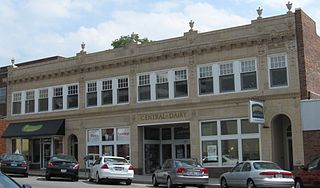
The Central Dairy Building, also known as Downtown Appliance and Gunther's Games, is a historic commercial building located in downtown Columbia, Missouri. It was built in 1927, and enlarged to its present size in 1940. It is a two-story brick building with terra cotta ornamentation elaborate classical and baroque design motifs. Also on the property is a contributing brick warehouse, constructed about 1940. Today the building houses an appliance store and restaurants on the first floor and lofts on the second.
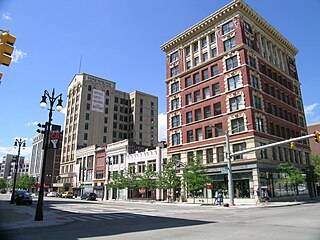
The Broadway Avenue Historic District is a historic district located on a single city block along Broadway Avenue between Gratiot and East Grand River in downtown Detroit, Michigan. It was listed on the National Register of Historic Places in 2004. The Broadway Avenue Historic District joins the Randolph Street Commercial Buildings Historic District, a rare surviving commercial area which dates from the 1840s.
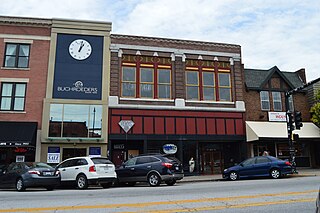
The Kress Building, also known as Kress Wholesale Company Store and Mehornay Furniture Store, is a historic commercial building located in downtown Columbia, Missouri. It was built in 1910 for the S. H. Kress & Co., and remodeled in about 1946. It is a tall two-story, brick building with an open storefront topped by horizontal metal banding, that consists of large plate glass windows. The building has seen a variety of uses and is currently host two night clubs: Roxy's on the second story, and The Piano Bar on the Ground.

The McCain Furniture Store Building is a historic commercial building located in downtown Columbia, Missouri. It was built about 1930 for the S. H. Kress & Co., and remodeled in 1951. It is a two-story, brick building with a simple stepped parapet. Though it has hosted a variety of businesses since the closing of the original store, today it holds Plasma Biological Services.
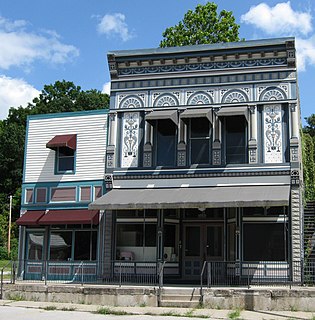
The Samuel E. Hackman Building, also known as the A.L. Barner Hardware Company Building, is a historic commercial building located at Hartsburg, Missouri. It was built in 1897 and expanded about 1903. It is a two-story, rectangular frame building with a flat facade. It features the original elaborate iron and frame storefront.

The Virginia Building, also known as the Strollway Center and Montgomery Ward Building, is a historic commercial building located at the corner of 9th and Cherry Streets in Downtown Columbia, Columbia, Missouri. It was originally built in 1911 to house one of the first urban Montgomery Ward department stores. It is a two-story building with a flat roof and gold brick walls. Today the building houses several local businesses including, the Cherry Street Artisan and Columbia Photo.

This is a list of the National Register of Historic Places listings in Clay County, Missouri.

The Western Union Telegraph Building in Kansas City, Missouri, is a former telecommunications building from 1920. It was listed on the National Register of Historic Places in 2003.

The Baker-Devotie-Hollingsworth Block is an historic building located in the East Village of Des Moines, Iowa, United States. The eastern two-thirds of the block was listed on the National Register of Historic Places in 1978 as the Studio Building. The western one-third was added to the National Register in 2008, and its name was changed at that time.

West End Commercial Historic District is a national historic district located at Greenville, South Carolina. It encompasses 15 contributing buildings in Greenville's second "downtown." The commercial buildings primarily date from about 1880 to 1920, and include examples of Victorian commercial architecture. Notable buildings include the American Bank, Alliance and Mills & McBayer Cotton Warehouses, Indian River Fruit Store, Pete's Place, Bacot's West End Drug Store/Stringer's Drug, Furman Lunch, and Greer Thompson Building.

Jackson Uptown Commercial Historic District is a national historic district located at Jackson, Cape Girardeau County, Missouri. The district encompasses 23 contributing buildings in the central business district of Jackson. It developed between about 1880 and 1953, and includes representative examples of Classical Revival style architecture. Notable buildings include the Cape Girardeau County Savings Bank, Kertsners's Drug Store, Cape Girardeau County Courthouse designed by P.H. Weathers, and Jones Drug Store.

Wood Building, also known as the Central Inn, Central Hotel, Central Tavern, Central Bar, Corner Inn, Corner Bar, Corner Pub, and Mac's Tavern, is a historic commercial building located at Cape Girardeau, Missouri. It built about 1908-1910, and is a rectangular, three-story, red brick, two-part commercial block building. It features an original, decorative sheet-metal cornice, a prominent parapet, and a cast-iron column at the recessed corner entrance.
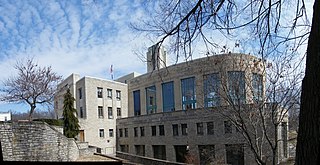
Excelsior Springs Hall of Waters Commercial East Historic District is a national historic district located at Excelsior Springs, Clay County, Missouri. It encompasses 24 contributing buildings and 2 contributing structures in the central business district of Excelsior Springs. The district developed between about 1894 and 1948, and includes representative examples of Victorian architecture. The central feature of the district, the separately listed Hall of Waters, is a five level, Art Deco / Depression Modern style reinforced concrete building. Other notable buildings include the Flanders Dry Goods Store, A.M. Howard Drug Store (1905-1909), Clay County State Bank (1906), The Huey Building (1908), Oriental Bazaar Gift Store (1908), The Excelsior Baths and Broadway Rooms, Fraternal Order of Eagles Lodge Hall, The Kennedy Building (1902), First National Bank Building, The Francis Hotel, and The Auditorium.

Marx–Hurlburt Building are two historic commercial buildings located at Springfield, Greene County, Missouri. They were built about 1900, and are two- and three-story, rectangular Classical Revival style commercial buildings.

Joe Knight Building, also known as Joe's Corner and Knight Drug Store, is a historic commercial building located at Lebanon, Laclede County, Missouri. It was built in 1948, and is a three-story, Streamline Moderne brick building with a flat roof. It features horizontal bands of windows and the curved corners are accented by large curved glass block walls. Dark bricks are also used to spell out "Joe Knight '48" and "Knight" on the main elevations.

Building at 217 West Main Street, also known as the Open Door Service Center Building, is a historic commercial building located at Sedalia, Pettis County, Missouri. It was built in 1874, and is a two-story, "L"-shaped, Italianate style brick building. A wing was added in 1906. It features a decorative metal cornice and three round arched windows. The building is known to have housed a brothel in the late-19th and early-20th centuries.

The Waterloo East Commercial Historic District is a nationally recognized historic district located in Waterloo, Iowa, United States. It was listed on the National Register of Historic Places in 2011. At the time of its nomination the district consisted of 36 resources, including 28 contributing buildings, and eight non-contributing buildings. The city of Waterloo was established in the early 1850s. Its first settlers started developing the west side of the city before crossing the Cedar River and developing east side. The first Black Hawk County Courthouse was built on the east side in 1856 and East Waterloo Township was created two years later. As industry began to develop along the river, and the arrival of the first railroad in 1861, the commercial district on the east side began to grow. Also on the east side of town was the terminus of the streetcar-turned-interurban system. By 1900, the city became one of the primary wholesale and retail centers in northeastern Iowa. In 1911 the Black population increased significantly as workers, primarily from Mississippi, moved into town to work for the Illinois Central Railroad. The following year the saloons in town were closed and bootlegging, gambling, drugs, and prostitution started to increase in the area surrounding the central business district. All of these developed put together created the atmosphere of the downtown commercial district.




























